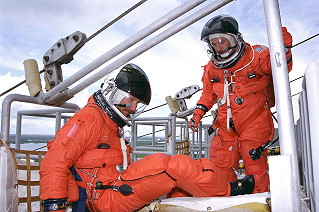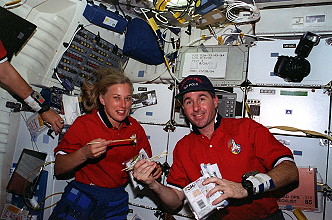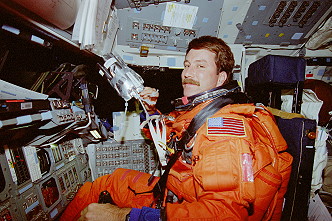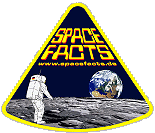Human Orbital Spaceflights
![]()
International Flight No. 198STS-85Discovery (23)86th Space Shuttle missionUSA |
 |
 |
 |
||
![]()
Launch, orbit and landing data
walkout photo |
 |
||||||||||||||||||||||||||||
alternative crew photo |
|||||||||||||||||||||||||||||
alternative crew photo |
|||||||||||||||||||||||||||||
alternative crew photo |
Crew
| No. | Surname | Given names | Position | Flight No. | Duration | Orbits | |
| 1 | Brown | Curtis Lee, Jr. "Curt" | CDR | 4 | 11d 20h 26m 58s | 189 | |
| 2 | Rominger | Kent Vernon | PLT | 3 | 11d 20h 26m 58s | 189 | |
| 3 | Davis | Nancy Jan | MS-1, PLC, RMS | 3 | 11d 20h 26m 58s | 189 | |
| 4 | Curbeam | Robert Lee, Jr. "Beamer" | MS-2, EV-1, FE | 1 | 11d 20h 26m 58s | 189 | |
| 5 | Robinson | Stephen Kern | MS-3, EV-2 | 1 | 11d 20h 26m 58s | 189 | |
| 6 | Tryggvason | Bjarni Valdimar | PS-1 | 1 | 11d 20h 26m 58s | 189 |
Crew seating arrangement
|
 |
|
||||||||||||||||||||||||||||
Hardware
| Orbiter : | OV-103 (23.) |
| SSME (1 / 2 / 3): | 2041-1 (3.) / 2039-1 (3.) / 2042-1 (2.) |
| SRB: | BI-089 / RSRM 57 |
| ET: | ET-87 (LWT-80) |
| OMS Pod: | Left Pod 01 (26.) / Right Pod 03 (24.) |
| FWD RCS Pod: | FRC 3 (23.) |
| RMS: | 301 (16.) |
| EMU: | EMU No. 3009 (PLSS No. 1009) / EMU No. 3017 (PLSS No. 1017) |
Flight
|
Launch from Cape Canaveral (KSC) and
landing on Cape Canaveral (KSC), Runway 33. In September 1996 Jeffrey Ashby was assigned to serve as a pilot on STS-85. He trained with the crew until March 1997 when he was named as an assistant to the Director, Flight Crew Operations. At that time Jeffrey Ashby withdrew from STS-85 to take care of his wife, who was dying of cancer. The deployment and retrieval of a satellite designed to study Earth's middle atmosphere along with a test of potential International Space Station hardware highlighted NASA's sixth Shuttle mission of 1997 with the launch of Shuttle Discovery on Mission STS-85. The prime payload for the flight, the Cryogenic Infrared Spectrometers and Telescopes for the Atmosphere-Shuttle Pallet Satellite-2 (CRISTA-SPAS-2) was making its second flight on the Space Shuttle and is the fourth mission in a cooperative venture between the German Space Agency (DARA) and NASA. The overall aim of the STS-85 mission was the study of several Mission to Planet Earth research interests, including atmospheric dynamics, atmospheric chemistry, long-term climate change and land cover/land use change around the world. The SPAS carrier was a battery-powered free flyer that will store data onto tapes for post-flight analysis. During this flight CRISTA's three telescopes made atmospheric observations along parallel tracks of trace constituents and temperature distributions. The scientific emphasis was on the study of small-scale tracer "filaments" (long, thin regions of differing atmospheric composition, including temperatures) in the stratosphere. By examining the atmospheric flow patterns of these elements, based on data collected during the previous STS-66 mission in November 1994 and new data collected during STS-85, researchers from 15 countries hoped to better understand how these filaments contribute to transport of ozone and chemical compounds that affect the distribution of ozone. STS-85 offered researchers an opportunity for increased latitudinal coverage of the atmosphere beyond that of data gathered during STS-66, providing data about summer conditions at high northern latitudes and the polar night at high southern latitudes. CRISTA's detailed high horizontal resolution information is very complementary to the less well resolved, but longer duration data from other free flyers, such as the Upper Atmospheric Research Satellite (UARS). During Discovery's flight, ground-based researchers were conducting extensive balloon, aircraft and sounding rocket campaigns to gather data to be compared with data collected by the three telescopes aboard CRISTA. During STS-66, CRISTA found several examples of tracer filaments in the atmosphere. CRISTA's unique viewing capabilities of the stratosphere, combined with new hardware upgrades since its last flight, will provide atmospheric scientists and researchers with valuable data upon which to build more accurate models on the transport and chemistry of ozone in the atmosphere. In the long term, this research may provide data on which to test the computer models about the transport processes that operate in the stratosphere. During recent years there has been significant theoretical development concerning atmospheric transport processes, especially relatively small-scale features, though opportunities to test these theories (and computational models) have been limited, especially above the levels of the stratosphere accessible to high-altitude research aircraft such as the ER-2. CRISTA also obtained measurements of the mesosphere and thermosphere and which may be helpful to shed new light on the interactions between the stratosphere and the overlying regions of the atmosphere. During STS-85 the Middle Atmosphere High Resolution Spectrograph Investigation (MAHRSI) focused on obtaining new vertical profile data on the distribution of hydroxyl (OH) in the mesosphere and upper stratosphere under very different conditions (both seasonal and diurnal) from its previous flight on STS-66. A goal of MAHRSI's flight was to provide global maps of the vertical distribution of OH and measurements of nitric oxide in the middle atmosphere. A major finding during MAHRSI's STS-66 flight was that the observed OH profiles differed significantly from those expected based on knowledge of distributions of water vapor and the measured rates of photochemical processes involved in production and destruction of OH. By using data from the Upper Atmospheric Research Satellite (UARS), as well as new data from the second flight of CRISTA/MAHRSI, researchers hoped to gain a better understanding of how hydroxyl behaves during different seasons around the globe and how it interacts with the behavior of ozone and other trace chemicals. The Space Shuttle provided exceptional opportunities for gathering OH data - since the location of OH for this research is between 25 and 75 miles (46 and 139 km) in altitude, the study's target area is too high for balloon research, and tends to be too quickly traversed by sounding rockets for the gathering of meaningful data. Currently, data for computer models of OH and its interaction with other atmospheric chemicals in this region of the atmosphere is scarce - MAHRSI and its unique spaceborne viewing of this area will provide for better understanding of OH and, therefore, ozone levels in the upper atmosphere, allowing for better models of Earth's atmosphere. During STS-85 MAHRSI also examined more closely the measurements of nitric oxide within the atmosphere. These measurements did not only provide a full global picture of nitric oxide in the mesosphere and thermosphere, but also were able to provide information on the spatial and temporal variability of nitric oxide. Information on variability of nitric oxide was obtained by taking advantage of the unique pointing capability of the SPAS platform to look at the same geographical location during several successive orbits. The Surface Effects Sample Monitor (SESAM) was a passive carrier for state-of-the-art optical surfaces to study the impact of the atomic oxygen and the space environment on materials and services. A few hours after the launch, Jan Davis used Discovery's robot arm to deploy the CRISTA-SPAS payload for about 9 days of free-flight. The crew retrieved the satellite with the help of the shuttle robot arm. The crew also supported the Manipulator Flight Demonstration (MFD) experiment being sponsored by NASDA, the Japanese Space Agency. MFD consists of three separate experiments located on a support truss in the payload bay. The primary objective was to demonstrate the newly designed dexterous robot arm in the space environment, before installing on the Japanese Experiment Module (JEM) of the International Space Station. Technology Applications and Science Payload (TAS-01) was a diverse Hitchhiker payload flying on STS-85. TAS-01 carried more experiments (eight) and weighed more than any previous Hitchhiker payload. The individual objectives of each experiment are described below, but the overall objective of the Hitchhiker payload was to fly more science experiments using better, faster, cheaper avionics and processes. The payload used standardized Hitchhiker avionics to provide power and enables command and transmission of experiment data to and from the payload. The Belgian SOLCON was a unique instrument designed to examine the effects of the total solar irradiance (TSI), or the Sun's total energy input into the Earth/atmosphere system, by using spaceborne radiometers to try and pinpoint within 0.01 percent the absolute value of the TSI. Solar energy was the only external source of energy for Earth, thus a primary natural driver for climate change. The measurement of TSI was important for researchers studying the effects of global warming. By making data observations from the Shuttle and the ability to return the instrument to Earth and recalibrate it, SOLCON provided an opportunity to measure the TSI without the potential spacecraft degradation from solar radiation that other orbiting instruments may suffer. Ultimately, SOLCON provided researchers with a "quality control" capability for checking continuously orbiting TSI measuring instruments. On STS-85 SOLCON researchers compared measurements of TSI with the DIARAD/VIRGO instrument aboard the SOHO spacecraft, and made comparisons to the ACRIM instrument aboard UARS. SOLCON flight operations worked in conjunction with the Belgian Space Remote Operations Center installed at the Royal Meteorological Institute of Belgium and performed experiments in preparation for experiment operations aboard the International Space Station. The Infrared Spectral Imaging Radiometer (ISIR) was a Space Shuttle Hitchhiker instrument that tested new technology and techniques for cloud observations from space. Clouds have a direct effect on heating of the Earth's surface, interacting with other aspects of the atmosphere in the control of ground temperatures. ISIR's new technology was infrared imaging with an uncooled detector array. A major limitation of infrared imagers in the past has been the bulky and difficult to use passive radiative coolers, or unreliable and expensive mechanical coolers, that are needed for research. Cooling systems for detector arrays also can require costly refurbishment, causing for instrument maintenance down-time. The new technology of the microbolometer focal plane arrays of ISIR allowed infrared imaging without external cooling. ISIR had three narrow band radiometers and one broad band radiometer. The uncooled microbolometer array aboard ISIR had 80,000 pixels with a swath width of 80 km and a spatial resolution of 250 miles (463 km). ISIR tested the potential of this new technology for much more compact, lower cost and more reliable spaceborne infrared imagers. The ultimate purpose of this study was to pave the way toward the next generation of operational Low Earth Orbiting observing satellites. The Shuttle Laser Altimeter (SLA) was a pathfinder for future operational space-based laser remote sensing devices and lidar. Similar to ISIR, SLA-2 was a Space Shuttle Hitchhiker payload. During the first flight of the instrument, SLA-01, flew in space successfully on STS-72 in January 1996 at a 28-degree inclination. That instrument demonstrated the viability of surface lidar sensing from Earth orbit, obtained a high-quality (meter-level accuracy) data set on ocean and land topography, and was a major factor in selection of the Vegetation Canopy Lidar for the first Earth Systems Science Pathfinder Mission. Tree height data sets obtained on SLA-01 were the first measurements from space that can be tied directly to remote sensing of above ground biomass and forest canopy architecture. This also was the first flight on the SLA instrument of a variable gain amplifier to extend the dynamic range for detection of faint laser echoes by over one order of magnitude. The Space Laser Altimeter-2 instrument gave direct measurements of the height of clouds, as well as acquired profiles of land and surface vegetation canopies over continental and island targets with a 1-10-meter rms surface elevation accuracy and sub-kilometer spatial resolution. The SLA instrument measured the distance from the Space Shuttle to the Earth's surface by timing the two-way propagation of short laser pulses. The SLA data system made the pulse time interval measurement to a precision of about five nsec and also recorded the temporal shape of the laser echo from the Earth's surface for interpretation of surface height distribution within the 100-meter diameter sensor footprint. For example, tree height can be determined by measuring the characteristic double-pulse signature that results from a separation in time of laser backscatter from tree canopies and the underlying ground. SLA-2 also measured the complex shape of laser pulse echoes from land and vegetation with sub-meter vertical resolution and obtained grids of altimetry data for major topography study regions, including the continental United States. Other primary targets for SLA-2 surface research included: the Amazon Basin in Brazil; the Canadian Boreal Forest; the Kamchatka Peninsula; the Patagonian ice fields; West Africa Tropical Forests; high latitude steppe deserts in China; large inland seas including the Caspian and Aral Seas; large oceanic islands, including Tasmania, the Falklands, and Madagascar; the Northern Sahara Sand Seas (Grand Ergs) and the Mississippi Delta region of the U.S. In addition to providing first ever observations of northern deciduous biomes, mountainous regions, and high plateaus, the SLA-2 data set should provide measurement of calibration and validation sites in the United States that are essential for understanding not only the SLA-2 observations but for scientific pathfinding and algorithm development for upcoming free-flyer surface lidar sensors. The Critical Viscosity of Xenon (CVX) experiment measured the viscosity of xenon under a set of conditions that cannot be achieved on Earth. A near-critical state of the fluid, xenon, has been chosen because many fluid properties (such as viscosity) exhibit remarkable changes near the critical point (a unique combination of temperature and density). The critical temperature, Tc = 16.7 degree centigrade for xenon, is the highest temperature at which gas and liquid can coexist for the chosen fluid. Viscosity increases significantly near critical temperature and precise measurement of the viscosity very near critical temperature will enable an improved understanding of the microscopic dynamics that underlie the viscosity increase. The measurement requires a test sample uniform in composition, temperature, and density. The CVX experiment employs: a precisely prepared sample of pure xenon; a unique viscometer (designed especially for this experiment); and a custom thermostat (providing temperature control to a few millionths of a degree). The experiment explored the vapor/liquid critical point, a second-order phase change at which the fluid properties are dominated by fluctuations in bulk properties rather than the details of atomic or molecular parameters. Theories which describe such phenomena are believed to be 'universal' and can be used to describe other interesting second-order phase changes such as the transition to superconductivity in mercury, the transition to ferro-magnetization in iron, and the transition to superfluidity in cryogenic helium. Thus, by testing the detail of existing, universal theories, the precise measurements the CVX experiment made in xenon will support improved understanding in other interesting and diverse fields. The Space Experiment Module (SEM) Program was an education initiative sponsored by NASA's Shuttle Small Payloads Project. The program provided nationwide educational access to space for kindergarten through university level students. Within the program, NASA provided small containers or modules to students to fly zero-gravity and micro-gravity experiments on the Space Shuttle. The experiments were created, designed, built, and implemented by students with teacher and/or mentor guidance. Student experiment modules are flown in a "carrier" which resides in the cargo bay of the Shuttle. The carrier supplies power to, and the means to control and collect data from each experiment, greatly simplifying the engineering process for students so that they can focus on creating science experiments. The Two Phase Flow (TPF) experiment characterized micro-gravity operations and demonstrate reliability of a capillary pumped loop (CPL) containing multiple evaporators. CPL's were developed at NASA's Goddard Space Flight Center and were the next major thermal control innovation since heat pipes. CPL's were two-phase heat transfer systems that use capillary wicks to move the ammonia working fluid from the instrument cooling interface to the spacecraft radiator for heat rejection to space. The CPL system contained no moving parts and required only a small amount of heater power to control the operating temperature. The capillary forced that move the fluid are very small when compared to Earth gravity, so a capillary system's operation on the ground can be very different from micro-gravity operation. These spaceflight experiments were required to demonstrate technology and provide data for computer models that predict future performance. Long term cryogenic cooling is an enabling technology for future space missions. It can be used to cool superconducting computers and sensors or to extend the capabilities of life support systems. The COOLLAR Flight Experiment (CFE) tested a Joule-Thomson (J-T) Cycle cryocooler designed to provide two stages of cooling. The objective of the COOLLAR Flight Experiment was to demonstrate the operation of a J-T cycle cryocooler designed for space applications. Of particular interest was demonstrating the collection and distribution of oil used to lubricate the long-life J-T compressor, and the collection, storage, and application of liquid nitrogen to provide uniform and precise temperature control of components with varying heat loads. SAAMD was a self-contained autonomous data acquisition system designed to measure low frequency acceleration in the Space Shuttle during launch and landing. The device was triggered by an inertia switch that is closed by the vibration of starting the main engines prior to launch and is triggered again by an inertia switch closed upon reentry. WBSAAMD measured acceleration at a higher frequency range. UVSTAR was an international payload sponsored by NASA and ASI, the Italian Space Agency. The experiment was a joint collaboration between the Universities of Arizona and Trieste. The goal was to study extended sources in the EUV bands. Key targets were planetary, such as the high temperature plasma confined in a toroidal ring around Io's orbit at Jupiter, remnants of supernovae with their expanding envelopes, the hot blue star content of the globular clusters, i.e. very dense stellar aggregates that give clue to our understanding of stellar evolution, and other, including targets of opportunity such as comets or special sudden events occurring in the sky. UVSTAR, which flew previously in 1995, consisted of several sets of hardware components: a twin telescope (which included a spectrograph system operating in two ultraviolet (UV) bands, a two axis platform which gave azimuth and elevation motion, a finder and tracker system for the pointing and tracking the targets, and several electronic boxes for running the instrument and acquiring the data. The two groups established a modern and updated astronomical instrumentation at low cost continuously upgrade the hardware, software and operational system, including a newly developed code that determines autonomously the pointing direction of the telescope. The SEH experiment was designed to accurately measure the solar flux (flux is the amount of light for a given area per second) in the extreme ultraviolet region of the solar spectrum. The EUV spectrum contains high energy, short wavelength light that does not penetrate the Earth's atmosphere. Because the atmosphere blocks these wavelengths, scientists must use instruments above the atmosphere, at an altitude of at least 125 miles (200 kilometers), to study this portion of the solar spectrum. The SEH instrumentation was most recently flown successfully on the Space Shuttle as part of the International Extreme ultraviolet Hitchhiker-1 (IEH-1) bridge, on Mission STS-69. On IEH-2, the solar system response to the solar input was observed by a complementary set of instruments, UVSTAR and SEH. Both SEH and UVSTAR are international cooperative experiments. On this mission, the UVSTAR instrumentation provided Jovian system extreme ultraviolet/far ultraviolet data, and SEH provided the required solar flux data for proper interpretation. Through such missions scientists will continue to provide the planetary community with the highest quality solar EUV data available. The Southwest Ultraviolet Imaging System (SWUIS) consisted of a baffled Ultraviolet (UV) 7 inch imaging telescope with A1/MgF2 (UV-reflective) optics, a manual filter changeout assembly, a UV-sensitive Intensified Charge Coupled Device (ICCD) Xybion camera, a telescope-to-camera coupling assembly, imaging filters and a SSP provided Video Interface Unit (VIU). The SWUIS telescope was used primarily to view the Hale-Bopp comet. However, it could also be used to perform ultraviolet astronomy, planetary and cometary imaging, terrestrial airglow and atmospheric background imaging, auroral imaging, or studies of Shuttle Glow and vehicle plume evaluations. Remote manipulator system (RMS) situational awareness displays (RSAD): The objective of this experiment was to demonstrate the use of RSAD before it is used operationally on International Space Station assembly flights. RSAD will integrate information pertaining to RMS from various sources, such as PCMMU, the Canadian Space Vision System; the Johnson Space Center Vision System; and any other system that may be developed to determine the position and attitude of a payload. The mission lasted a day longer than originally planned due to a threat of ground fog at Kennedy Space Center. |
Photos / Graphics
 |
 |
 |
 |
 |
 |
 |
 |
 |
 |
 |
 |
 |
 |
 |
|
more Earth observation photos |
|
| © |  |
Last update on March 27, 2020.  |
 |